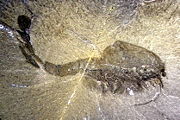
Waptia
Encyclopedia
Waptia fieldensis was a small, shrimp
-like stem group crustacean
. Many Cambrian
crustaceomorphs such as Waptia lack the mouthparts to be classified as crown group
crustaceans that lived during the Middle Cambrian about 510 million years ago.

Shrimp
Shrimp are swimming, decapod crustaceans classified in the infraorder Caridea, found widely around the world in both fresh and salt water. Adult shrimp are filter feeding benthic animals living close to the bottom. They can live in schools and can swim rapidly backwards. Shrimp are an important...
-like stem group crustacean
Crustacean
Crustaceans form a very large group of arthropods, usually treated as a subphylum, which includes such familiar animals as crabs, lobsters, crayfish, shrimp, krill and barnacles. The 50,000 described species range in size from Stygotantulus stocki at , to the Japanese spider crab with a leg span...
. Many Cambrian
Cambrian
The Cambrian is the first geological period of the Paleozoic Era, lasting from Mya ; it is succeeded by the Ordovician. Its subdivisions, and indeed its base, are somewhat in flux. The period was established by Adam Sedgwick, who named it after Cambria, the Latin name for Wales, where Britain's...
crustaceomorphs such as Waptia lack the mouthparts to be classified as crown group
Crown group
A crown group is a group consisting of living representatives, their ancestors back to the most recent common ancestor of that group, and all of that ancestor's descendants. The name was given by Willi Hennig, the formulator of phylogenetic systematics, as a way of classifying living organisms...
crustaceans that lived during the Middle Cambrian about 510 million years ago.
Behaviour
Waptia-like arthropods discovered in the Chengjiang form chains of up to 20 individuals, with each animal's tail nested in the carapace of the one behind. These chains must have been rigid to be preserved.

